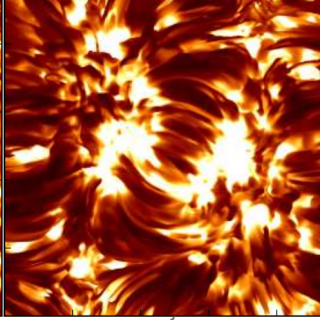Bibcode
Rezaei, R.; Bello González, N.; Fischer, C. E.
Referencia bibliográfica
Astronomy and Astrophysics, Volume 602, id.L12, 5 pp.
Fecha de publicación:
6
2017
Revista
Número de citas
10
Número de citas referidas
8
Descripción
Context. Observations of multi-wavelength and therefore height-dependent
information following events throughout the solar atmosphere and
unambiguously assigning a relation between these rapidly evolving layers
are rare and difficult to obtain. Yet, they are crucial for our
understanding of the physical processes that couple the different
regimes in the solar atmosphere. Aims: We characterize the
exploding granule event with simultaneous observations of Hinode
spectroplarimetric data in the solar photosphere and Hinode broadband Ca
II H images combined with Interface Region Imaging Spectrograph (IRIS)
slit spectra. We follow the evolution of an exploding granule and its
connectivity throughout the atmosphere and analyze the dynamics of a
magnetic element that has been affected by the abnormal granule.
Methods: In addition to magnetic flux maps we use a local correlation
tracking method to infer the horizontal velocity flows in the
photosphere and apply a wavelet analysis on several IRIS chromospheric
emission features such as Mg II k2v and Mg II k3 to detect oscillatory
phenomena indicating wave propagation. Results: During the
vigorous expansion of the abnormal granule we detect radially outward
horizontal flows, causing, together with the horizontal flows from the
surrounding granules, the magnetic elements in the bordering
intergranular lanes to be squeezed and elongated. In reaction to the
squeezing, we detect a chromospheric intensity and velocity oscillation
pulse which we identify as an upward traveling hot shock front
propagating clearly through the IRIS spectral line diagnostics of Mg II
h&k. Conclusions: Exploding granules can trigger
upward-propagating shock fronts that dissipate in the chromosphere.
Movies associated to Figs. A.1 and A.2 are available in electronic form
at http://www.aanda.org
Proyectos relacionados

Magnetismo, Polarización y Transferencia Radiativa en Astrofísica
Los campos magnéticos están presentes en todos los plasmas astrofísicos y controlan la mayor parte de la variabilidad que se observa en el Universo a escalas temporales intermedias. Se encuentran en estrellas, a lo largo de todo el diagrama de Hertzsprung-Russell, en galaxias, e incluso quizás en el medio intergaláctico. La polarización de la luz
Ernest
Alsina Ballester